


When 'MVL' employs sharp openings with black pieces, you can expect certain things:
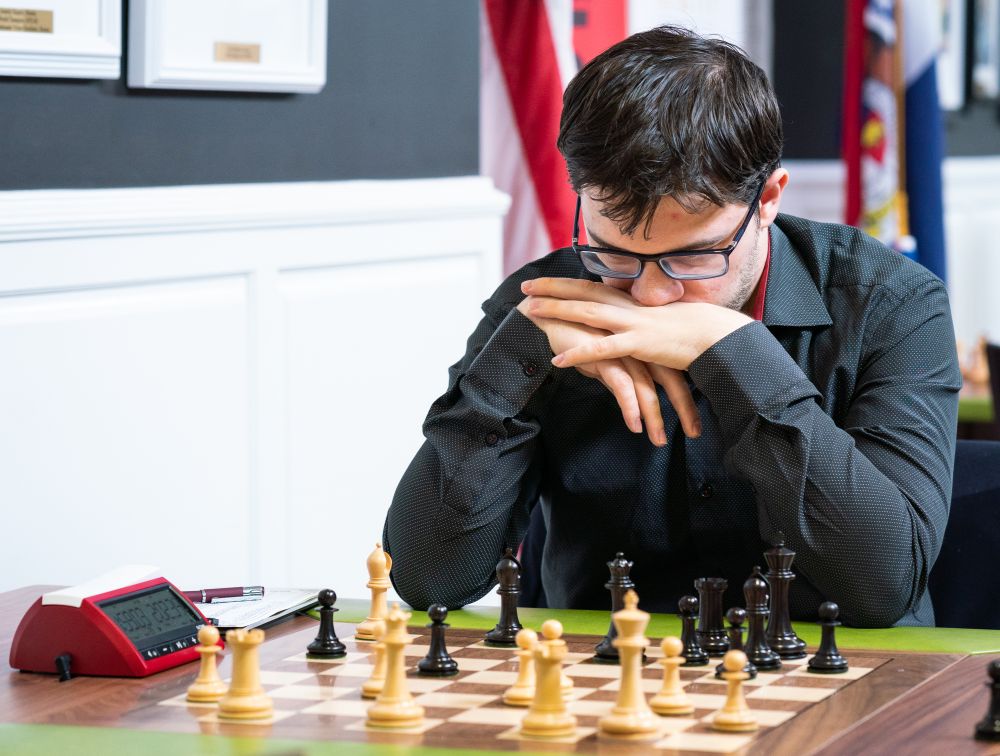
Vachier-Lagrave — forgetting preparation and losing a game | Photo: Lennart Ootes / Grand Chess Tour
In the Sinquefield Cup this year itself, he played such an opening against Caruana in the sixth round, and today too. From a sharp variation of the Gruenfeld Defence, the contestants reached a position which they have already duelled with in the past.
A typically sharp position from the Gruenfeld, where black has sacrificed a pawn but white pieces aren't coordinating too well. In such positions, application of logical principles would not help beyond a certain point. The position should already have been analysed at home in depth, and the conclusions only get tested against each other on the board.
One of their earlier encounters went 14.♗e2 here, and today Karjakin came up with 14.♗d5 ♞g4 15.g3 ♞xe3 16.fxe3 a6!?
The players were blitzing out the moves at this stage, and it is pointless to analyse the position here — it is too sharp and can be analysed thoroughly only with painstaking thoroughness.
17.♘d4
Curiously, MVL has played this position before with the white pieces! His game against Gelfand in 2013 went 17.♗xf7 ♚h8!? 18.♘d4 etc. with a wild position. This is another curious topic, that a player can be at both the sides of the same position. The inevitable question: how do they find a way to win in a position with either colour, if they are sure of playing them with opposite colours?!
17...bxc5 18.♖b1 Played after an eight minutes of thought, thus indicating that White has finally reached the end of his opening preparation and started playing over the board, at last.
18...♛a7 MVL continued playing fast, indicating that he was very much still in his preparation. But the curious point was, both of Black's moves were not approved by the engines, and after 19.♘c6 black was in serious trouble.
What went wrong with MVL's preparation? Talking after the game, MVL revealed that, his loss in this game was 'very well deserved'.
I played 17...bxc6 without thinking. Immediately after playing I realized that it was not I was supposed to play!
He was supposed to play 17...♝h3, and he just did not forget his preparation, but it was even worse a case of 'remembering after playing what I was supposed to play' as he termed it.
A curious incident — a top player who is meticulously prepared in sharp positions ends up forgetting the line, but continues playing fast and ends up in a poor position almost without consuming time all through.
Remaining of the game was an excellent piece of technical conversion by Karjakin. The challenger to the throne of 2016 hasn't shown much of his prowess in this tournament so far, and it was wonderful to see him in his best shape in the featured queen and opposite colour bishops endgame.
31...♝d4 The move looked optically attractive, but White had his trumps intact 32.♗c4 ♝xe3? 33.♕d7+ ♚h6 34.♕h3+ ♚g7 35.♕e6 ♝d4 36.♕f7+ ♚h6 37.a5 and White went on to win.
Of course, 32...♛xe3?? would have been a blunder as 33.♕xe3 ♝xe3 34.a5 and white wins the opposite colour bishop ending easily. Black had a better defence with 32...♛f6 but white still wins with 33.♔g2 ♝c3 34.♕d7 ♚h6 35.♗g8 ultimately pinning the black queen to defend the king thus enabling the a-passer to roll on.
But in all the above analysis, it is a difficult to task to play flawlessly over the board, and Karjakin almost displayed great skill.
The second game which gladdened everyone's mood was the world champion's daring play from the beginning of the game. First of all, Carlsen showed his good frame of mind by visiting the confession booth early on and delighted the audience,
“This is a little something for our Norwegian viewers. I just happen to spill some milk waiting here for the game, but I am not crying about it!”
...with a sweet wink too! (Later on he explained that he had literally spilled milk before the game started).
Last year we got a 🤫, this year we get a 😉 pic.twitter.com/O1EUcEjlFD
— Grand Chess Tour (@GrandChessTour) August 25, 2019
Carlsen had his first serious thought here, and pressed for an initiative with 23.♗c4 ♚g7 24.♖eh4 ♚g6!
Black plays with guts. Still, Carlsen had a mild chance of taking over the initiative with a precise sequence of moves: 25.♗d3+ ♚f7 26.♗f2! (with the idea of ♗f2-c5 and continue hunting the black king) 26...b6 27.♗e4 ♝d7 28.♖h7 ♚e6 29.♔d1! ♝a3 30.♖4h6 with the threat of ♘f3-g5+ as well as ♗g3-h4, which would give White an initiative. But he erred with 25.♖h7? and almost could not generate any great initiative afterwards.
Understandably, Carlsen was dejected after the game that he couldn't find anything, and congratulated his opponent for defending an 'extremely dicey position'. “I played virtually a no-risk position, but he managed to get out of that”.
He lamented that he wasn't getting any momentum in the tournament yet, drawing all his games so far,
Situation is getting more dire by the day. Today I put (Ding) to some very very serious tests, but that's all you can do. You don't win chess games unless your opponent makes mistakes.
Fatalistic or realistic?
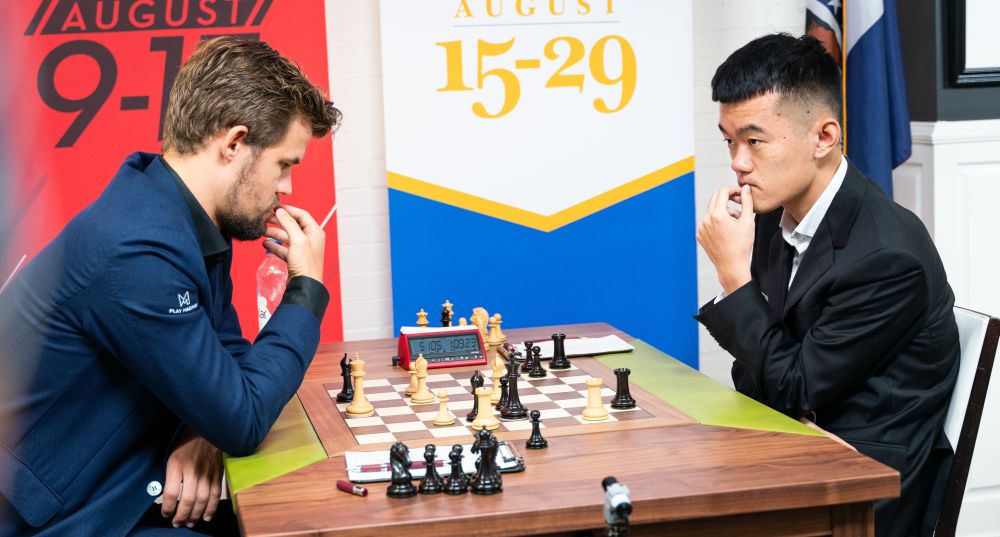
Carlsen vs Ding: a great fight | Photo: Lennart Ootes / Grand Chess Tour
If at all anyone was having a completely bad day, it was Levon Aronian, winner of the just concluded Saint Louis Rapid and Blitz.
Black has achieved equality, and a healthy plan such as 15...♛d7 followed by Ra8-d8 looked to be on the cards. Aronian continued 15...♞h7?! Where is he going with this? 16.a4 ♞f8? 17.b4! White fixes weaknesses in Black's position on the queenside 17...♞g6 What has Black achieved with this entire relocation of the knight? 18.♗e3 ♝xe3 19.fxe3 and white seemed to possess a slight initiative.
20.♘d2! The knight is headed to c5, from where it ensured that White got a winning advantage. Honestly, the rest of the play till the endgame was substandard by Aronian's standards, as he slowly slipped into a losing position, though White made inaccuracies too.
45.♔f1 If 45.♕f2 Black can simply capture pawns with 45...♛xc3 46.♕xh4 ♛xb4 and White doesn't have a win any more. 45...♛f4?? A counter-blunder. Black has a brilliant defence here with 45...♚d7 46.c4 ♚c6!! and Black might be able to hold the game! 46.♕f2 and White went on to win.
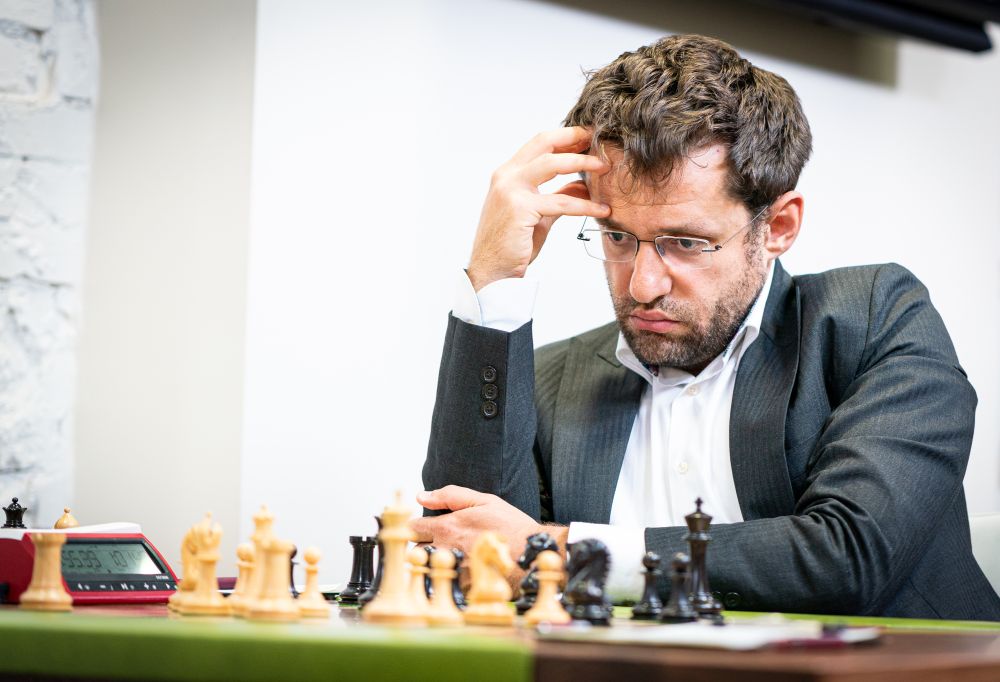
Levon Aronian — a bad day at the office | Photo: Lennart Ootes / Grand Chess Tour
Since there was lots of criticism on the web for lack of decisive games in the tournament, here's the question: A game may produce a result, which makes fans excited, but do you really enjoy a game where such blunders take place? Isn't fighting play important for the content of a game rather than a result produced due to uneven play?
Another player who decided to mount a big fight on this day was Shakhriyar Mamedyarov. Having had an uneven tournament, his fighting abilities looked to be under question especially after his poor fight against Wesley So in the sixth round. But it was a completely different player who turned up at the board today.
In a familiar position from the Moscow variation of the Slav, Shakhriyar decided to infuse tactics with 8.♘e5 ♝g7 9.f4 ♞d7 10.h4!? and it was obvious that he had come to the board thirsting for a fight. Giri revealed that this whole plan was 'very dangerous' for Black, but didn't expect Mamedyarov to know it, as 'he hasn't played this for ages, it's not a part of his repertoire'.
This was the moment that Giri dazzled. After 17 minutes of thinking, he came up with 14...f6! But at the same time, after Mamedyarov continued 15.♕xg6 — the obvious capture — Giri took another 34 minutes for his reply 15...fxe5. What happened between those two instances?
When I ask him after the game, he swears that 'it was not my prep'.
It was like, I look at something, later I forget it, start to think, come up with certain ideas, and then the thought gets frozen in the back of my mind. Then I have to think again to recollect them. I usually play much better than this!
After an admirable fight, the crux of the game happened when Giri was already under time pressure.
White's previous move was a mistake, and here Black had a chance to take over the initiative with 22...dxc4 23.♗xc4 ♜f5! But he preferred the safe 22...♜d8? and allowed the draw with 23.g6 ♜f6 24.♕h8!
When I checked with him if he considered 22...dxc4, he confessed that he had got unnerved by 22.♕h3?! taking quite some time to understand the point behind, that White wanted to cover the f5 square when he plays g5-g6.
“I knew (d5xc4) was possible on every move, but I had only 10 minutes on the clock. I just saw 22...♜d8, and saw that he didn't have any other logical move to prolong the fight and hence will be forced to take a draw. I went for it”.
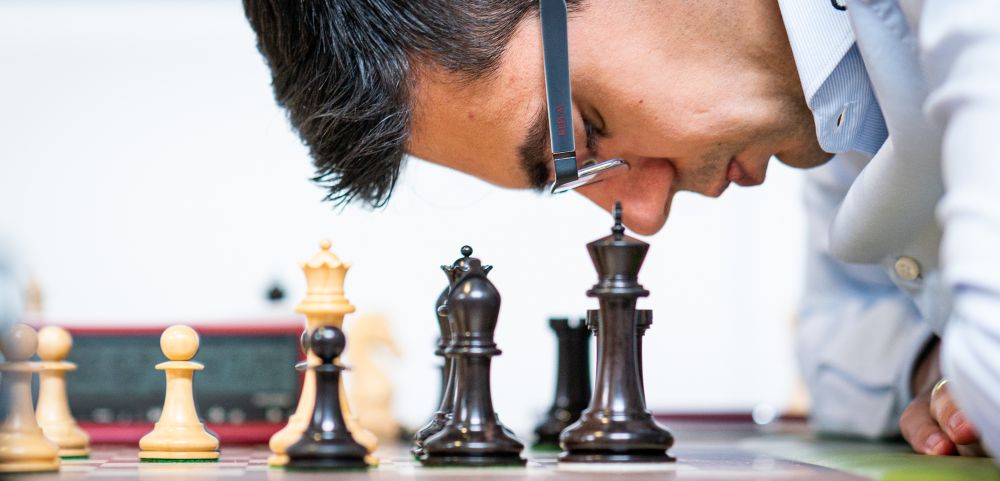
Anish Giri – working with his nose to the grindstone | Photo: Lennart Ootes / Grand Chess Tour
The most awaited clash of the day didn't produce much excitement, except that Viswanathan Anand held a slight edge throughout the game, only to misplay it and allow Fabiano Caruana to equalise at some point in the late middlegame. Surprisingly, Anand wasn't happy about the game, terming has play as terrible.
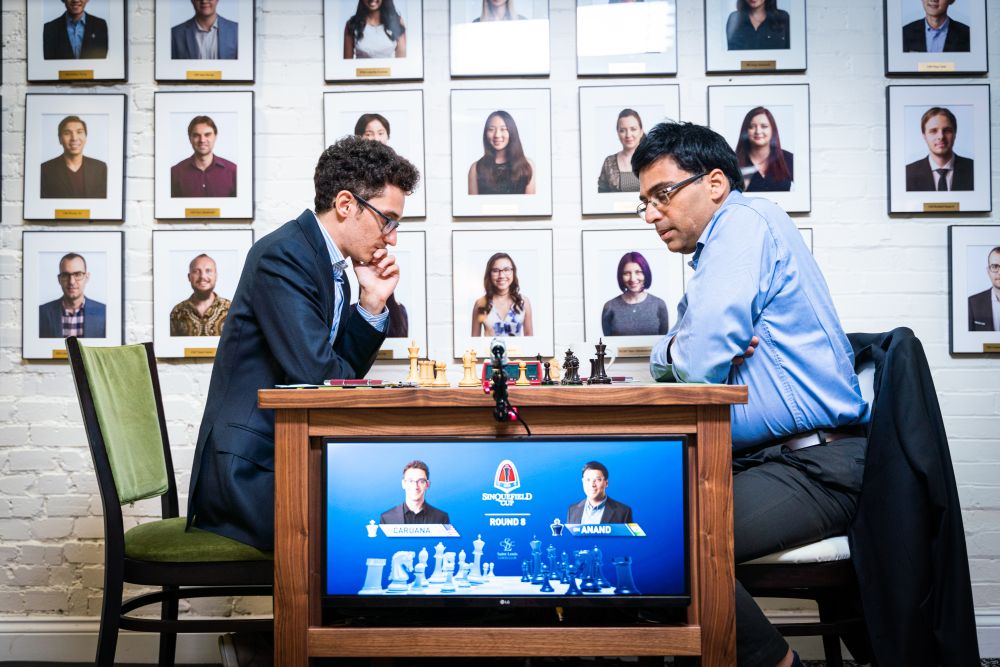
Caruana vs Anand — just a regular day at the office | Photo: Lennart Ootes / Grand Chess Tour
He was still smarting under the missed opportunities in his game against Ding, after which he was playing the tournament with no expectations, “I don't care, after yesterday, I'll just play (each round) and see”, was a surprisingly low prediction from the former world champion.
Commentary by WGM Jennifer Shahade and GMs Yasser Seirawan and Maurice Ashley